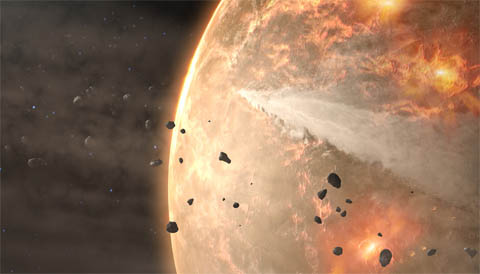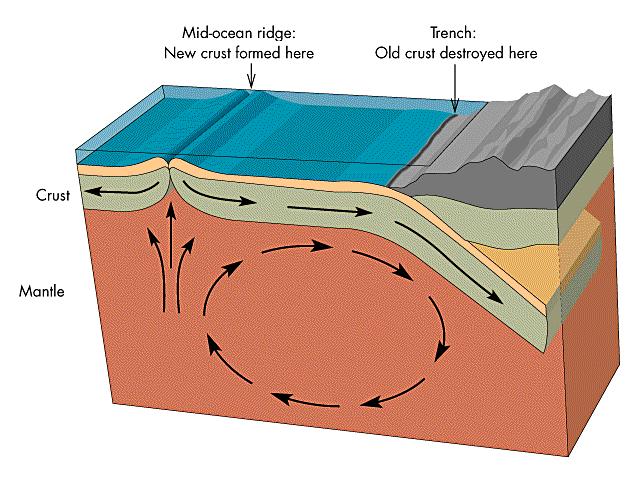Where, exactly, did our oceans come from? New research suggests that asteroids might have both delivered and removed lots of water — and that Earth itself might have locked it away deep inside.
Ours is the only planet with abundant liquid water on its surface, and life (as we know it) wouldn't be possible without it. While Mars might have been warmer and wetter very early in its history, and Venus might have had an initial infusion of water that it later lost, somehow we lucked out and continue to splash with abandon.
Geologists don't think Earth's water has been here all along, however. Even if our planet assembled from chunks of water-rich primordial matter, the titanic impact that ripped into our infant planet and led to the Moon's formation would have radically altered the status quo. That impact, less than 100 million years after the solar system coalesced, would have melted Earth's crust and mantle to great depth, driving off any water as superheated steam — along with any primordial atmosphere that might have existed.
So where did all the water come? It's long been thought that comets were the natural source. The total volume of water on Earth is about 1.4 billion cubic kilometers, (332,500,000 mi3), and it would take a few thousand comets, each 50 km (30 miles) across, to deliver all that. Such a barrage seems impossible now, but it would have been very likely early in solar-system history. It was during what planetary geologists term the late heavy bombardment (LHB) between 4.1 and 3.8 billion years ago, that the Moon's face gained most of its craters and giant basins. Earth would have likewise been relentlessly pummeled.

NASA
However, it must have been a give-and-take scenario. New computer modeling suggests that impacts could have both increased and removed Earth's atmosphere. Calculations by Hilke Schlichting (MIT) and two colleagues at Hebrew University confirm previous assessments that a single enormous impact — such as the one from a Mars-size body thought to have triggered the Moon's formation — likely stripped most if not all of the atmosphere.
But thousands of smaller impacts would also do the trick, each ejecting a localized pocket of gas irretrievably into space. It'd take tens of thousands of these events to blast away the entire atmosphere, Schlichting and her colleagues report in February's Icarus (full paper here). A bombardment of that magnitude likely occurred during the LHB, which many dynamicists now believe was triggered by an abrupt shifting of the giant planets' orbits.
One way to safeguard a water-rich atmosphere would be to stash lots of the stuff deep down in Earth's mantle. That's the thinking of Wendy Panero and Jeff Pigott (Ohio State University), who envision that Earth's constant cycling of massive crustal slabs — the plate tectonics unique to our planet — could have preserved huge amounts of water in the mantle rocks and then, eventually, returned it to the surface.

sanandreasfault.org
Panero and Pigott were alerted to this possibility when they discovered tiny flecks of the silicate mineral ringwoodite in a diamond that formed at great depth. The most common mineral in Earth's lower mantle is perovskite, a silicate whose crystalline structure can't store many stray hydrogen atoms (which combine with oxygen to form water). But lots of hydrogen atoms can be stashed in ringwoodite, which exists in a broad layer about 500 to 800 km (300 to 500 miles) deep. The hydrogen got there thanks to slabs of water-rich oceanic basalt forced down into the mantle along subduction zones.
So has Earth simply regurgitated water that's been stored for eons in its mantle? Perhaps, and in fact the work by Panero and Pigott (presented at last meeting of the American Geophysical Union) suggests that a Pacific Ocean's worth of water remains locked up down below.
However, geophysicists believe that plate tectonics (I prefer the little-used but more correct plate tectonism) might not have started until Earth was already a billion years old — by which time any primordial water was likely long gone. So perhaps Earth's oceans were imported after all — not from comets, however, but predominantly from water-rich asteroids.
You'll appreciate the interplay of the continents and oceans as never before with Sky & Telescope's terrific new Earth globe.
 1
1
Comments
ROBERT STENTON
January 2, 2015 at 7:23 pm
It took some time for the earth to first form continents and more time for them to break up and become subducted so additional sources of water are needed. It is possible for a lot of our water to have formed right here on earth from oxygen in our rocks and hydrogen ejected from an earlier and more active sun in the form of solar wind. Water is still being created in this manner. When the earth was hit by a mars sized object, a lot of material would have been forced downward into the mantle that would have held water. Meteorites are very porous and soak up water like a sponge so asteroid material could well have held frozen water. Comets are of course a reasonable source. Added all together, the real problem to solve may be why we have so little water.
You must be logged in to post a comment.
You must be logged in to post a comment.